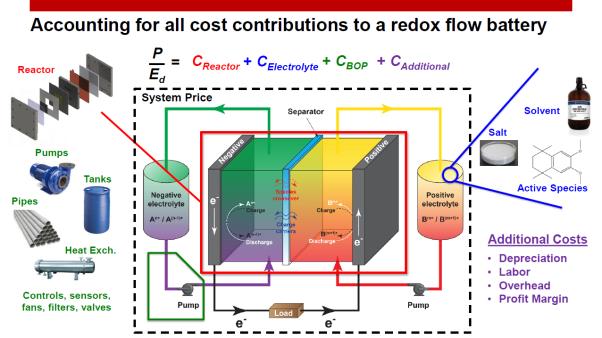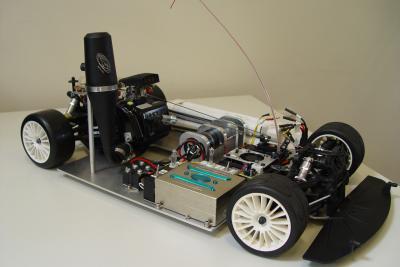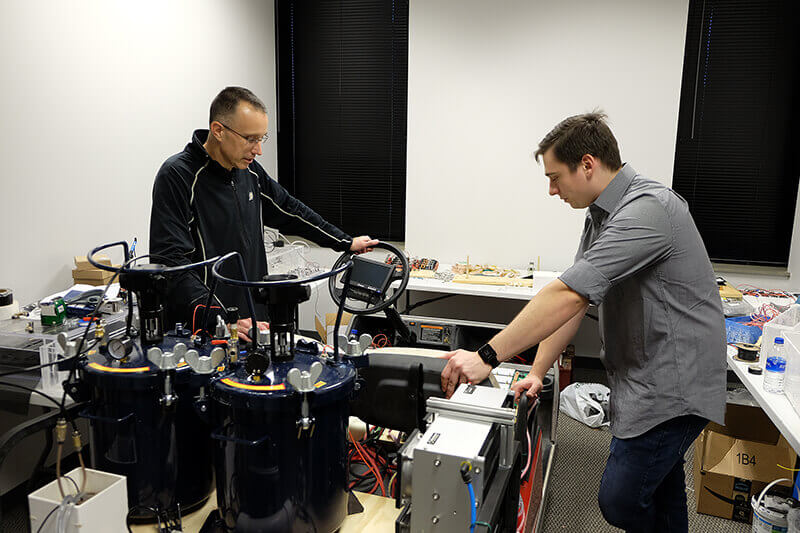Electric car flow battery technology stores energy in liquid electrolytes. These electrolytes flow through a system to generate electricity.
Electric car flow batteries offer a promising solution for energy storage and efficiency in electric vehicles. Unlike traditional batteries, flow batteries use liquid electrolytes stored in external tanks. This design allows for easy scaling of energy capacity by simply increasing the size of the tanks.
Flow batteries can recharge quickly and provide longer life cycles, making them ideal for sustainable transportation. They also reduce the dependency on rare earth materials, promoting eco-friendly practices. As the demand for electric vehicles grows, flow battery technology could play a crucial role in advancing the industry and achieving greener transportation solutions.

Credit: www.purdue.edu
Introduction To Flow Battery Technology
Electric cars are the future of transportation. They need efficient and reliable batteries. One promising solution is Flow Battery Technology. This technology offers several advantages for electric vehicles.
What Is A Flow Battery?
A flow battery is a type of rechargeable battery. It stores energy in liquid electrolytes. These electrolytes are stored in external tanks. The size of the tanks can be adjusted. This allows for scalable energy storage. The electrolyte flows through a cell stack. The cell stack converts chemical energy to electrical energy.
| Feature | Details |
|---|---|
| Energy Storage | Liquid electrolytes in external tanks |
| Scalability | Adjustable tank sizes |
| Energy Conversion | Chemical to electrical via cell stack |
Importance For Electric Vehicles
Flow batteries are crucial for electric vehicles. They offer long life cycles. This means fewer battery replacements. Flow batteries are also safe. They have a low risk of catching fire. This makes them ideal for electric cars. Another benefit is fast charging. Electric cars can charge quickly. This reduces downtime for drivers.
- Long life cycles – fewer replacements
- Safety – low fire risk
- Fast charging – reduced downtime
Flow batteries can also handle heavy use. They are designed for high performance. This is perfect for electric cars. Electric vehicles need reliable and powerful batteries.

Credit: www.electronicspecifier.com
How Flow Batteries Work
Flow batteries are a promising technology for electric cars. They offer unique advantages in energy storage. Understanding how they work can explain their potential.
Basic Principles
Flow batteries store energy in liquid electrolytes. These electrolytes flow through the system. They convert chemical energy into electrical energy. The process is reversible, allowing for recharging.
Components And Operation
Flow batteries have three main components:
- Electrolyte Tanks: These store the liquid electrolytes.
- Flow System: This pumps the electrolytes through the battery.
- Electrochemical Cell: This is where the energy conversion occurs.
Here’s how the operation works:
- The electrolytes are pumped from the tanks.
- They flow through the electrochemical cell.
- A chemical reaction occurs, producing electricity.
- The used electrolytes return to the tanks for recharging.
The flow battery continues this cycle, providing a sustainable energy source. Electric cars benefit from this technology. It offers fast recharging and long life. Understanding flow batteries helps us see their potential in the future of electric cars.
Advantages Over Traditional Batteries
Electric car flow battery technology offers significant advantages over traditional batteries. These advantages make it a promising choice for the future of electric vehicles. Let’s explore some key benefits of flow batteries.
Extended Lifespan
Flow batteries last much longer than traditional batteries. They can endure many more charge cycles. This results in fewer replacements over the lifetime of a car.
Flow batteries also maintain their performance better. They do not degrade as quickly over time. This ensures your electric vehicle remains efficient for years.
Rapid Charging Capabilities
Flow batteries support rapid charging. This means you can charge your car quickly. No more long waits to get back on the road.
Faster charging times improve convenience. They make electric cars more practical for everyday use. You can spend more time driving and less time charging.
| Feature | Flow Batteries | Traditional Batteries |
|---|---|---|
| Charge Cycles | High | Low |
| Degradation Rate | Low | High |
| Charging Time | Rapid | Slow |
Flow batteries bring significant benefits to electric cars. They offer a longer lifespan and rapid charging. These advantages make them a smart choice for the future.
Challenges And Limitations
Electric car flow battery technology promises many benefits. However, it faces several challenges and limitations. Understanding these challenges is crucial for future advancements.
Current Technical Barriers
Several technical barriers hinder the development of flow batteries for cars. One major issue is the energy density. Flow batteries have lower energy density than lithium-ion batteries. This means they store less energy per unit of volume.
Another technical barrier is the complexity of the system. Flow batteries are more complex to design and maintain. They require pumps, tanks, and other components that add weight and bulk.
Efficiency is also a concern. Flow batteries are less efficient in converting energy compared to other batteries. This leads to energy losses that reduce the overall performance.
Economic Considerations
Flow batteries also face economic challenges. One key issue is the high initial cost. These batteries require expensive materials and components, making them costly to produce.
Maintenance costs are another economic factor. Flow batteries need regular maintenance to ensure optimal performance. This adds to the overall cost of ownership.
Market adoption is slow due to these high costs. Many consumers and businesses are hesitant to invest in new, expensive technology.
| Challenges | Details |
|---|---|
| Energy Density | Lower than lithium-ion batteries |
| System Complexity | Requires additional components |
| Efficiency | Lower energy conversion efficiency |
| Initial Cost | High due to expensive materials |
| Maintenance Cost | Requires regular upkeep |
| Market Adoption | Slow due to high costs |
Recent Innovations
Electric car flow battery technology has seen remarkable recent innovations. These advancements promise to revolutionize energy storage and efficiency. Let’s explore some of the most significant breakthroughs and emerging technologies in this field.
Breakthroughs In Material Science
Material science has experienced significant breakthroughs. Researchers are developing new electrolytes to enhance battery performance. These electrolytes improve energy density and reduce costs. Scientists are also creating advanced membranes to increase battery lifespan.
| Breakthrough | Impact |
|---|---|
| New Electrolytes | Enhanced energy density, reduced costs |
| Advanced Membranes | Increased battery lifespan |
Another key development is the use of nano-materials. These materials improve conductivity and power output. They also make batteries safer and more reliable. The integration of these materials marks a new era in battery technology.
Emerging Technologies
Several emerging technologies are shaping the future of electric car batteries. One exciting development is the use of AI and machine learning. These technologies optimize battery management systems. They help predict maintenance needs and improve efficiency.
- AI for battery management
- Machine learning for predictive maintenance
Another promising area is the development of solid-state flow batteries. These batteries offer higher energy densities. They are also more stable and have a longer lifespan.
- Higher energy densities
- More stable
- Longer lifespan
Wireless charging technology is also gaining traction. This technology enables convenient, cable-free charging. It enhances the overall user experience for electric car owners.
The combination of these innovations is paving the way for a more sustainable future. The advancements in material science and emerging technologies are transforming electric car flow battery technology.
Impact On Ev Market
The impact of flow battery technology on the electric vehicle (EV) market is profound. This new technology promises to revolutionize how we power our cars. Below, we explore key areas affected by this innovation.
Market Growth Projections
Flow battery technology is expected to boost the EV market growth significantly. Industry experts predict a sharp rise in EV adoption. This is due to the unique advantages of flow batteries.
- Longer battery life: Flow batteries last longer than traditional lithium-ion batteries.
- Faster charging: They charge quicker, reducing downtime for drivers.
- Cost-effective: Lower long-term costs make EVs more affordable.
A study forecasts that the global EV market will grow by 20% annually. This growth is largely due to advancements in battery technology.
Adoption By Major Automakers
Major automakers are quickly adopting flow battery technology. Companies like Tesla, Ford, and GM are investing heavily in this area. They recognize the potential benefits for their electric vehicle lineups.
| Automaker | Investment (in billions) | Projected EV Models |
|---|---|---|
| Tesla | 10 | 5 |
| Ford | 8 | 4 |
| GM | 7 | 6 |
These companies aim to capitalize on flow batteries’ benefits. They are focusing on increasing vehicle range and reducing charging times.
Tesla plans to introduce five new EV models by 2025. Ford and GM also have ambitious plans for the near future.
Environmental Benefits
Electric Car Flow Battery Technology offers numerous environmental benefits. This innovative technology helps reduce pollution and promotes sustainable practices. Let’s explore some of these benefits in detail.
Reduced Carbon Footprint
Flow batteries help cut down on carbon emissions. Electric cars with flow batteries produce fewer greenhouse gases. This technology uses renewable energy sources, such as solar and wind. These sources do not emit harmful gases.
Traditional cars burn fossil fuels. They release carbon dioxide and other pollutants. Electric cars with flow batteries rely on clean energy. This reduces the overall carbon footprint.
Sustainable Manufacturing Processes
Flow batteries are made using sustainable methods. These methods reduce waste and use eco-friendly materials. Manufacturers focus on recycling and reusing components.
The production process of flow batteries involves less energy consumption. This helps in conserving natural resources. Sustainable manufacturing also reduces harmful byproducts.
Here is a table showing the comparison:
| Aspect | Traditional Batteries | Flow Batteries |
|---|---|---|
| Energy Source | Non-renewable | Renewable |
| Emissions | High | Low |
| Waste | High | Low |
By adopting flow battery technology, we can achieve a greener future. This technology supports environmental conservation and responsible manufacturing practices.

Credit: phys.org
Future Prospects
The future of electric car flow battery technology looks promising. As we move towards cleaner energy, these batteries could play a key role. They offer longer life spans and faster charging times. Let’s explore the exciting prospects ahead.
Next-generation Developments
Next-generation flow batteries are under intense development. These batteries promise higher energy densities and improved efficiencies. Researchers are working on new materials for better performance. Advanced electrolytes could make these batteries more durable.
These improvements will reduce costs and enhance reliability. Check out the table below for more details:
| Feature | Current Generation | Next-Generation |
|---|---|---|
| Energy Density | 50 Wh/L | 100 Wh/L |
| Charging Time | 4 hours | 2 hours |
| Cost | $300/kWh | $150/kWh |
Potential For Global Adoption
The potential for global adoption of flow batteries is huge. Many countries are pushing for renewable energy sources. Electric cars with flow batteries can meet this demand. They offer better performance and lower costs.
Several factors make global adoption likely:
- Government incentives for green technologies
- Growing environmental awareness
- Technological advancements in battery design
These factors create a favorable environment for flow batteries. As technology improves, adoption rates will increase. This will help in reducing greenhouse gases and pollution.
Frequently Asked Questions
Can Flow Batteries Be Used In Electric Cars?
Flow batteries are not ideal for electric cars due to their size, weight, and lower energy density compared to lithium-ion batteries.
What Are The Disadvantages Of Flow Batteries?
Flow batteries have a high initial cost. They require complex maintenance. They have lower energy density. They need large storage space. They have slower response times compared to other batteries.
What Is The New Flow Battery Technology?
New flow battery technology uses liquid electrolytes stored in external tanks. It offers longer life, quick recharge, and scalability.
What Is The Latest Technology Around Electric Car Batteries?
The latest technology in electric car batteries is solid-state batteries. They offer higher energy density, faster charging, and improved safety compared to traditional lithium-ion batteries. This innovation could significantly extend electric vehicle range and reduce charging times, making EVs more efficient and practical for everyday use.
What Is A Flow Battery In Electric Cars?
A flow battery stores energy in liquid electrolytes, offering longer life and faster recharge.
Conclusion
Electric car flow battery technology offers a promising future for sustainable transportation. It enhances efficiency and reduces environmental impact. As advancements continue, these batteries may become the standard in electric vehicles. Embracing this technology can lead to cleaner and more efficient travel.
Stay informed and consider the benefits of flow batteries.
